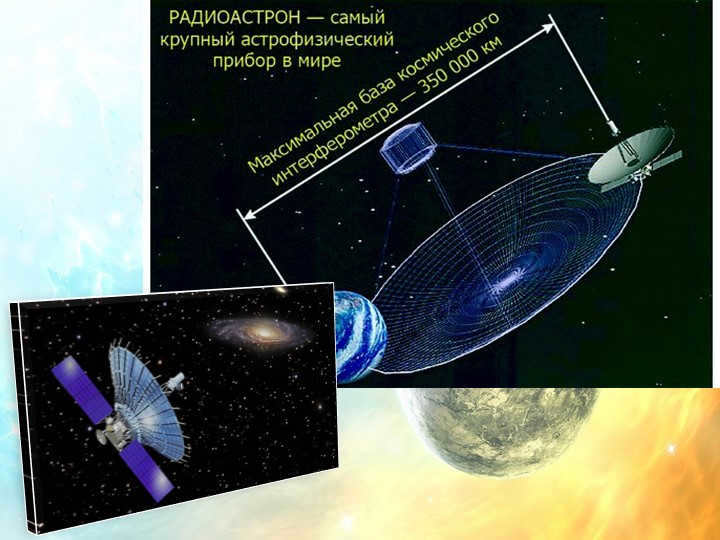Astronomy holds the title of being the oldest scientific discipline that explores the organization of the universe. Its name originates from the Greek words astron (stars) and nomos (law), which together mean “stellar law”. Throughout history, astronomy has maintained a remarkable level of advancement, especially during ancient times.
Interconnection between astronomy and other fields of study
Philosophy and its relation to astronomy. The exploration of the fundamental principles governing the organization of the universe is intricately linked to the study of astronomy. As a result, ancient scholars classified astronomy as a philosophical science.
Astronomy facilitates the understanding of the Earthly realm by investigating various cosmic entities (such as galactic and stellar systems, stars, comets, planets, and asteroids) and phenomena (such as eclipses and planetary oppositions).
The very concept of “astronomy” itself demonstrates the same idea: the laws that govern the stars also apply to the Earth, as it is a part of the Universe and follows the same universal laws. It is through these laws that all known sciences are derived by Earthlings. The progression of the Universe is propelled by the established movements of celestial bodies: galaxies form and evolve, stars ignite and fade away.
A significant number of breakthroughs in astronomy have been made by individuals who are not professional astronomers.
This fact illustrates that astronomy is one of the few fields of study that allows individuals from diverse backgrounds and professions to contribute as observers and gather valuable data.
Astrology and Astronomy. Astrology, once acknowledged as a pseudoscience, played a beneficial role in its time by inspiring the advancement of practical astronomy.
Theology and astronomy. Ancient astronomers, who recognized the distinction between stars and planets, associated this knowledge with the supernatural realm, attributing all discovered cosmic objects to celestial forces and various deities. As a result, the profession of astronomer became the domain of religious servants (priests, magi, clergy, etc.). Frequently, the grandest structures of antiquity – such as the temples of ancient China, Mayan observatory temples, or the megalithic Stonehenge – served dual purposes, both astronomical and religious in nature.
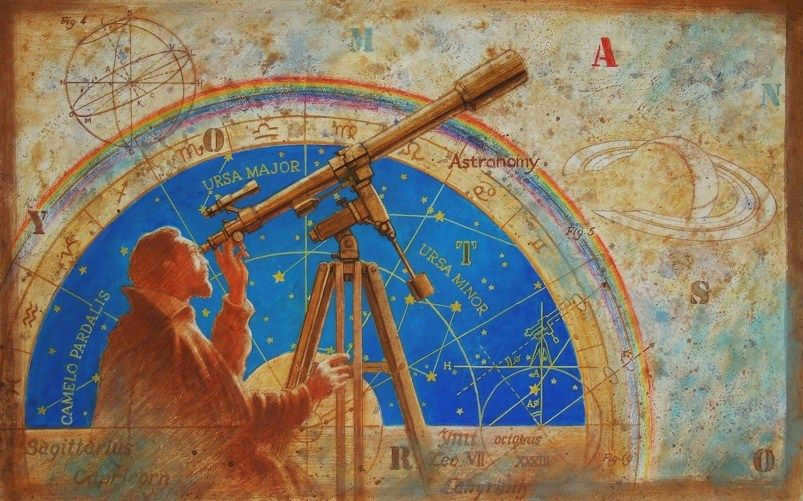
Figure 1: Astronomical observations in the early 17th century. Author24 – Internet exchange of student works
Astronomy and its impact on shaping the human perception of the world
The knowledge gained through the study of astronomy plays a crucial role in shaping a coherent worldview. In the past, the lack of accurate information about celestial objects often led to a misconstrued understanding of the universe’s structure.
In ancient times, people believed that the Earth was supported by three elephants standing on a giant turtle. The Sun and the Moon were worshiped, and meteorites were seen as omens of disaster. Eclipses of the Moon and the Sun were associated with terrible events. However, modern astronomy has provided evidence of the natural evolution of the universe, without the need for supernatural forces. This has brought clarity and stability to human understanding of existence.
In the modern era, astronomy has allowed humans to dismiss superstitions, leading to a positive impact on their mental well-being and a more accurate worldview.
Practical uses of astronomy
Astronomy’s methodology and knowledge have a significant impact on modern society. Specialized time services, established through astronomical research, have solved the problems of time measurement and provided accurate time values for the human community.
The technique of astronomical orientation continues to be utilized by sailors, aviators, and now astronauts. Astronomical data allows for the proper scheduling of agricultural activities, as well as sea and air transportation.
Astronomical methods enable the correction of geographical and topographical maps, the determination of tidal phenomena characteristics in the oceans, and the calculation of gravity force in various locations on Earth’s surface, thereby identifying areas of metal and mineral accumulation.
The exploration of phenomena occurring on celestial bodies provides scientists with the opportunity to study matter in states that are not yet attainable on Earth’s surface. As a result, the branches of astronomy closely linked to the natural sciences pave the way for their development and contribute to technological advancement. Astronomical knowledge has been the primary driving force behind the design and creation of artificial satellites and spacecraft.
For a considerable period of time, the Soviet Union has been at the forefront of space exploration. Utilizing their expertise in the field of astronomy, the USSR was able to make numerous groundbreaking discoveries:
- The identification of the Earth’s magnetosphere.
- The detection of the solar wind.
- Pioneering steps in lunar investigation (including a flyby around the Moon, capturing images of the dark side, deploying a lunar rover, and successfully delivering lunar soil samples to Earth).
- The initial exploration of Venus (comprising the study of its atmosphere, landing a probe on its surface, and capturing the first images of the Venusian landscape).
- The first comprehensive investigations of Mars, its moon Phobos, and Halley’s comet.
For ages, humans have been endeavoring to comprehend the enigma of the Grand Universe, known as Cosmos by the ancient Greek thinkers. The initial thoughts regarding the Universe surrounding us were articulated by ancient Greek philosophers during the 7th-5th centuries BC.
These philosophical concepts were built upon the preceding astronomical wisdom of the Egyptians, Sumerians, Babylonians, and Aryans, but stood out due to their hypothesis-driven explanations and the quest to delve into the very core of the Universe and its clandestine mechanisms.
ASTRONOMICAL PICTURE OF THE WORLD
The field of astronomy underwent a significant transformation in the 20th century. With the advent of space telescopes and other advancements in science and technology, it became possible to create more accurate star maps and make the study of the cosmos and the concept of the astronomical picture of the world more accessible.
Contemporary telescopes enable the observation of galaxies that are 13.5 billion light years away from our planet. Currently, scientists and astronomers have documented entirely novel celestial objects and phenomena for the first time.
Before 1995, the Universe was a barren wasteland devoid of water. Research carried out between 1996 and 1998 revealed that water exists throughout the Universe and appears to aid in the condensation of gas-dust clouds, extracting heat from them and playing a role in the creation of planets. Each year, as astronomers explore uncharted regions and mechanisms of the Universe, they arrive at conclusions that may diverge greatly from the beliefs of their ancient predecessors, all due to the constant progress that is being made.
Modern astronomy has made groundbreaking discoveries in the vastness of space, unveiling not only unconventional phenomena but also completely new processes. One such phenomenon is gamma-ray bursts, which are cataclysmic events on a cosmic scale. These bursts emit radiation with a power equivalent to that of all the stars in the visible Universe combined. The energy released during a gamma-ray burst can range from 1051 to 1054 ergs, capable of wiping out life within a radius of tens or even hundreds of light years. Scientist Trofimenko A.P. has proposed that these bursts are caused by the flashes of anti-collapsing ottons, objects that fall under the realm of general relativity.
In the latter half of the 20th century and the early 21st century, the acquisition of information about the Universe is achieved through four distinct channels.
The primary channel consists of electromagnetic waves, encompassing various ranges including the optical spectrum. Research is conducted across the entire electromagnetic spectrum, not just limited to the optical range. Currently, over 60% of our understanding of celestial bodies and processes is derived from non-optical segments of the electromagnetic spectrum. This encompasses the longest radio waves to the shortest gamma rays. The data gathered from X-rays and gamma rays is particularly valuable. X-ray telescopes yield crucial information about phenomena such as black holes and background radiation. Similarly, gamma-ray astronomy provides insights into solar flares, pulsars, and neutron stars.
Neutrino astronomy can be considered as a third avenue of study. Neutrinos have a weak interaction with matter and are challenging to detect. However, they carry valuable information about various celestial phenomena such as stellar processes, solar activities, and supernova explosions.
Additionally, gravitational waves serve as the fourth channel of exploration. These waves are generated by massive stellar explosions and there is substantial evidence supporting their existence and the potential of gravitational astronomy.
Thus, it can be concluded that in the latter half of the 20th century, astronomy unveiled three new avenues of investigation while also expanding on previously established ones. In essence, modern astronomy builds upon existing knowledge, enhances it through technological advancements, and uncovers new insights that address numerous queries about the Universe.
The advancement of astronomy as a scientific discipline has resulted in a notable expansion of the observed region of the Universe and the detection of several extraordinary phenomena and celestial objects. Furthermore, the identification of the information-phase state of material systems serves as a valuable addition that substantially alters our existing understanding of the structure of the world.
The theory of self-organization plays a crucial role in shaping a fresh scientific perspective of the world. It investigates various self-organizing systems composed of numerous subsystems, such as electrons, atoms, molecules, cells, neurons, organs, complex multicellular organisms, humans, and communities of individuals. Contemporary notions of self-organization enable us to reconcile the discrepancy between the theory of biological evolution and thermodynamics.
Science and technology are constantly advancing, indicating that our understanding of the cosmos will continue to evolve. As scientists develop new tools and techniques, they are able to explore and answer questions about space in ways never before possible. The latest advancements in technology have greatly aided their research efforts. For those who have a curiosity about the unknown depths of space, there are always opportunities to delve deeper and discover new wonders. In today’s modern world, we have a vast array of resources and possibilities to study and understand the Universe.
The Significance of Astronomy in Shaping our Understanding of the World
Interest in celestial bodies and processes has been present since the early days of Homo sapiens. Observations of the sky allowed for the identification of a connection between astronomical phenomena and the changing seasons, which greatly influenced the way ancient humans lived. The predictability of most astronomical events enabled accurate predictions of corresponding earthly processes and phenomena. This led to the emergence of the first scientific discipline – astronomy, followed by the development of mathematics, chemistry (which evolved from alchemy), geography, geology, biology, and finally physics. However, astronomy remained a leading science for a long time, with practical applications such as navigation, and shaping the worldview of people. Advances in astronomy have repeatedly revolutionized our understanding of the world. One notable example is the transition from the geocentric view of the universe to the heliocentric view. Another significant change was the rejection of the concept of a finite celestial sphere and the acceptance of the infinite universe with its multiple worlds and galaxies.
T.P. Sergeeva,
is a senior researcher at the Main Astronomical Observatory of the National Academy of Sciences of Ukraine.
Astronomy has had several significant impacts:
1. It revolutionized navigation by introducing the astrolabe, which enabled sailing beyond the visible shores. Before the invention of star charts and the sextant, sailors could only venture out sporadically and rely on the sun for navigation, limiting their journeys to distances no greater than a solar day.
2. Astronomy has also been a catalyst for the advancement of numerous scientific disciplines. It has contributed to the development of optics, mathematics, mechanics, archaeology, history, and chemistry through various research endeavors.
3. The progress made in astronomy has provided insights into the length of the day, which has had implications for increasing agricultural productivity.
Astronomy is a scientific field that explores the growth and structure of the universe in its entirety – encompassing the formation and progression of stars, pulsars, planets, and the cosmos as a whole.
The aims of astronomy are as follows:
- Observation and examination of celestial objects visible to astronomers, including their sizes, shapes, locations, and movements.
- Investigation into the composition, physical properties, and chemical properties of these celestial bodies.
- Exploration of the origins of celestial objects and the systems they comprise.
- Development and formulation of theories regarding the origins and evolution of the observable portion of the Universe.
Astronomy has played a crucial role in the progress of human civilization and continues to do so.
The historical significance of astronomy
In the past, an understanding of celestial movements and positions was essential for various calculations related to agriculture and religious practices.
For instance, in ancient Egypt, the annual flooding of the Nile coincided with the rising of the star Sirius. The observation of this star enabled Egyptian priests to accurately predict the floods, which were vital for agricultural planning. Furthermore, the priests in ancient Egypt were able to accurately determine the duration of the solar year – 365 days.
Within the interfluve of the Tigris and Euphrates rivers, located in present-day Iraq, the knowledge surrounding the movement of celestial bodies played a crucial role in the practices of irrigation and agriculture. The credit for the development of the hexadecimal counting system can be attributed to the priests of Mesopotamia.
One notable application of this counting system is the way we measure time, where 60 minutes and 60 seconds form the basis of our system.
Over the course of centuries and millennia, the concept of dividing the starry sky into specific groups, known as constellations, was passed down through generations. This is how the Babylonian priests introduced astrology, which was initially a support system for a select group of highly educated priests, but has since transformed into a tool for profit and the exploitation of vulnerable individuals.
Works available on a similar topic
Since ancient times, dating back to the era of ancient Greece and Rome, people have come to understand that the Earth is not a flat surface supported by elephants and a turtle, but rather a spherical object. This realization was first made by the renowned ancient Greek philosopher Aristotle. By observing a solar eclipse, he noticed that the shadow that envelops the Earth’s surface during this phenomenon takes on a circular shape. Based on this observation, Aristotle deduced that the Earth must be round. He believed that the Earth was the center of the universe.
However, well before Nicolaus Copernicus, the ancient Greek philosopher Aristarchus of Samos, who lived in the 3rd century BC, put forward a completely different theory. He proposed that the Sun is the central body, with the Earth rotating around it and on its axis, resulting in the cycle of day and night.
Nevertheless, for an extended period of time, the prevailing belief was the geocentric system, which was developed by the ancient Greek scientist Claudius Ptolemy, who lived in the 2nd century AD in Egypt, which was then a part of the formidable Roman Empire.
According to Ptolemy’s concepts, the Earth occupies the central position, with the planets and the Sun orbiting it in concentric paths. This notion held sway for a considerable duration.
The emergence of capitalist relations in Europe and the great geographical discoveries sparked the advancement of science, including the field of astronomy.
In the 17th century, Nicolaus Copernicus, a Polish astronomer, provided evidence that the Earth is not the center of the universe, while Giordano Bruno discussed the existence of multiple worlds. Renowned astronomers and mathematicians such as Galileo Galilei, Kepler, Tycho Brahe, and others also made significant contributions to the field. Russian scientist Mikhail Lomonosov played a role in expanding our knowledge about celestial bodies.
This accumulation of new knowledge in astronomy brought about a revolution in people’s perspectives. Rather than viewing the Earth as the proud center of the universe, it was now seen as a unique and insignificant place, lost in the vastness of space, where life existed.
The significance of astronomy in the modern era
The present state of astronomy owes its progress to the remarkable scientific and technological breakthroughs of the 20th century. The advent of rocket technology paved the way for space exploration.
Today, astronomy enables humanity to acquire fresh knowledge and explore new frontiers beyond the confines of our terrestrial abode. It enables us to track the trajectory of asteroids and meteorites that pose potential hazards to our planet.
Astronomy in the contemporary era is intricately linked with the advancement of space travel and rocket science, the study of planets within our solar system, and the discovery of exoplanets resembling Earth.
The impact of astronomy on culture
Astronomy has played a significant role in shaping the cultural beliefs and practices of humanity throughout history.
For instance, the ancient builders of Stonehenge in England utilized their knowledge of astronomy to accurately track the solstice. Similarly, the celebration of Shrovetide has become a symbol of the arrival of spring, influenced by astronomical observations. In the realm of Christianity, the Star of Bethlehem holds great significance as it is believed to have heralded the birth of Jesus Christ.
The advancement of astronomy and the acquisition of new knowledge about the cosmos have not only contributed to scientific progress but have also had a profound impact on various forms of literature. Scientific, philosophical, and fantastical works inspired by astronomy have captivated readers for centuries, fueling their imagination with ideas of distant stars and the vast expanse of the universe.
Keeping up with literature and film, there seems to be a new space-themed release almost every week.
However, there are some negative aspects associated with astronomy. On one hand, there is an overwhelming amount of information, and on the other hand, people tend to either accept it uncritically or overly critically, which distorts both personal and public understanding.
As a result, astrology has experienced a resurgence in popularity since the Soviet Union fell, even though there is no evidence to support its predictions.
This supercritical perception and lack of logic has given rise to conspiracy theories, such as the idea that Americans never landed on the moon, that cosmonauts were sent into space before Gagarin, who supposedly died in space, and even the absurd concept of a flat earth, which has resurfaced in the 21st century.
The future role of astronomy
In the current era, progress in space and rocket science has experienced a slowdown compared to the mid-20th century. This can be attributed to the enormous costs involved and a lack of clear incentives for the political and financial entities governing nations.
Therefore, the time is now opportune for astronomy and its related fields to take center stage in the pursuit of knowledge and the advancement of space exploration. It is inevitable that the Earth cannot indefinitely remain the cradle of humanity, and our future generations will eventually need to venture beyond this familiar abode. Astronomy, serving as a guide in the vast expanse of the cosmos, will rightfully assume a crucial role.
The Importance of Astronomy Education for Russian Schoolchildren
The current state and future prospects of astronomy
The necessity for widespread astronomical education arises from the significance of astronomy’s contribution to constructing a scientific understanding of the world and fostering a scientific mindset among contemporary individuals.
Astronomy is the field of study focused on the Universe, examining the fundamental physical properties, composition, structure, origin, and evolution of celestial objects and their systems, space phenomena, and cosmic processes.
Within all historically established models of the Universe, which encompass the overarching theoretical concepts from specific eras of scientific advancement – mechanical, electrodynamic, quantum-field, quantum-relativistic, and contemporary quantum-cosmological – astronomical knowledge has played an especially significant, if not foundational, role.
Contemporary astronomy is a comprehensive and multifaceted field of study that encompasses both wave and particle aspects. It is an empirical discipline that investigates celestial objects across the entire electromagnetic spectrum, examining their development and mutual interactions. The advancements in space technology enable astronomers to directly observe and analyze cosmic entities, as well as the various phenomena and mechanisms that occur within the universe.
The key accomplishments of contemporary astronomy include:
– Elucidation of stellar evolution through the development of models and validation through observational evidence.
– Investigation into the overall dynamics of galaxies, comprehension of the structure of spiral galaxies, and the revelation of galactic nuclei and quasars’ activity.
– Establishment of the Metagalaxy’s structure, with comprehensive understanding of the Universe’s processes within a timeframe of up to 10 billion years from the present.
– Affirmation of the theories regarding star and planetary system formation from gas-dust complexes, as well as the concept of a non-stationary Universe.
– Substantial expansion of knowledge concerning the nature and physical properties of celestial bodies within the Solar System and the Sun, acquired through space exploration.
Due to the ongoing scientific and technological revolution, the field and significance of astronomical knowledge are expanding. New branches of astronomy are emerging, and new scientific methods and instruments are being developed to enhance the comprehensiveness, precision, and productivity of astronomical observations.
Astronomical research has gained practical importance, playing a key role in the advancement of physics, chemistry, and other natural sciences, as well as technology and energy. The interplay between astronomy and other disciplines, technology, and culture is multifaceted, varied, and sometimes unclear.
The conversion of the Earth’s technological civilization’s scientific and production activities into a significant force on a global scale, with a profound and mostly adverse impact on the biosphere, atmosphere, hydrosphere, and geological processes of our home planet, presents unprecedented global challenges for humanity to transition to a fundamentally different path of sustainable development (SD), as outlined by the UN Conference on Environment and Development in 1992. In Russia, a governmental initiative to shift towards SD was formulated in 1994-95.
Given the increasing susceptibility of modern civilization to the influence of extraterrestrial factors, the objectives of terrestrial ecology necessitate both astronomical observations and observations from space, encompassing not only the Earth but also the immediate surrounding space.
The special significance of mankind’s universal uniqueness becomes apparent in the context of technological advancement and significant social changes. In each cosmic phenomenon and process, we witness the expression of fundamental laws of nature. Astronomical research serves as the foundation for the principles of understanding matter and the Universe, as well as crucial philosophical generalizations. The influence of astronomy on the development of philosophical teachings remains steadfast.
These factors contribute to the enduring interest of the general public, particularly the younger generation, in astronomy and space exploration. It is imperative for every modern educated individual to be familiar with the fundamental concepts of astronomy. Therefore, astronomy education plays a vital role in the overall education of society.
Astronomy plays a crucial role in modern society, particularly in the measurement of time and the provision of accurate time information. To address these issues, specialized laboratories called time services have been established, typically associated with astronomical institutions.
Astronomical methods of orientation continue to be widely used in navigation, aviation, and more recently, in astronautics. Additionally, astronomical knowledge forms the basis for the calculation and creation of calendars, which are extensively utilized in the national economy.
Astronomical methods are also essential in the compilation of geographical and topographical maps, the prediction of sea tides, and the determination of gravity at different locations on Earth’s surface for the purpose of discovering mineral deposits.
Studying the processes that occur on different celestial bodies provides astronomers with the opportunity to examine matter in states that have not yet been replicated in terrestrial laboratory conditions. As a result, astronomy, particularly astrophysics, which is closely connected to physics, chemistry, and mathematics, contributes to the advancement of these fields,
which, as we all know, form the foundation of all modern technology. It is worth mentioning that astrophysicists were the first to raise the question of the role of intra-atomic energy, and the greatest accomplishment of modern technology – the development of artificial celestial bodies (such as satellites, space stations, and spacecraft) – would be unimaginable without the knowledge gained from astronomy.
Astronomy plays a vital role in combating idealism, religion, mysticism, and superstition. Its significant contribution lies in shaping a correct dialectical-materialist worldview by determining the Earth’s position and mankind’s place in the vast Universe. Although the observation of celestial phenomena alone does not provide direct insight into their true causes, the absence of scientific knowledge often leads to incorrect explanations, superstitions, and the deification of these phenomena and celestial bodies. In ancient times, for instance, the Sun, Moon, and planets were worshipped as deities, forming the basis of various religions and worldviews that centered around the idea of Earth’s central position and immobility. Superstitions related to solar and lunar eclipses, comets, meteors, and meteorite falls persisted throughout history, and some still hold onto them today. Comets were believed to be omens of disasters, such as fires, disease epidemics, and wars, while meteors were thought to be the souls of the deceased ascending to the sky.
By studying celestial phenomena, examining the nature, structure, and evolution of celestial bodies, astronomy provides evidence for the materiality of the universe and its natural, orderly progression in both time and space, without any intervention from supernatural forces.
Astronomy is a scientific field that explores the development and structure of the Universe in its entirety, including the formation and evolution of stars, pulsars, planets, and the Universe itself.
The goals of astronomy encompass:
- The observation and analysis of visible celestial bodies, focusing on their sizes, shapes, locations, and movements.
- Investigating the composition, physical properties, and chemical properties of the celestial bodies under examination.
- Formulating and developing a theory regarding the emergence and progression of the observable portion of the Universe.
Astronomy has played a significant role in the advancement of human civilization.
The historical significance of astronomy
In ancient times, understanding the movements and positions of celestial bodies was essential for various calculations related to agricultural practices and religious ceremonies.
For instance, in ancient Egypt, the annual flooding of the Nile river coincided with the rising of the star Sirius. By observing this star, the Egyptian priests were able to predict the floods, which were crucial for farming. Additionally, the priests of ancient Egypt accurately calculated the duration of the solar year, which is 365 days.
In the region between the Tigris and Euphrates rivers, located in modern-day Iraq, the knowledge of celestial movements was also utilized to aid in irrigation and agriculture. The priests of Mesopotamia are credited with inventing the hexadecimal counting system, which has had a lasting impact on humanity.
An example of this system’s application can be seen in our timekeeping system, which is based on 60 minutes and 60 seconds.
Over the course of centuries, the concept of dividing the starry sky into specific groups, known as constellations, has been passed down. The Babylonian priests played a significant role in the development of astrology, which has since evolved from a tool utilized by a select few highly educated individuals into a means of profiting off and deceiving the gullible.
Prepared works on a similar subject
Even in ancient times, dating back to the civilizations of ancient Greece and Rome, individuals discovered that the Earth is not a flat entity supported by elephants and a turtle, but rather a spherical object. This realization was reached by the renowned ancient Greek philosopher Aristotle. By observing a solar eclipse, Aristotle noticed that the shadow that obscures the sunlight during this phenomenon takes on a circular shape. Based on this observation, Aristotle deduced that only the Earth could produce such a shadow, leading him to conclude that the Earth is spherical in shape. Additionally, Aristotle believed that the Earth occupied a central position within the universe.
However, well before Nicolaus Copernicus, there was an ancient Greek philosopher named Aristarchus of Samos who lived in the 3rd century BC. He proposed a completely different theory, suggesting that the Sun was actually the center and that the Earth revolved around it on its axis, causing the cycle of day and night.
Despite Aristarchus’ revolutionary idea, it was the geocentric system that prevailed for a considerable period of time. This system was developed by the ancient Greek scientist Claudius Ptolemy, who lived in Egypt during the 2nd century AD when it was part of the mighty Roman Empire.
According to Ptolemy’s theories, the Earth is positioned at the center while the planets and the Sun travel in concentric paths around it. This concept held sway for many centuries.
Following the collapse of the Western Roman Empire in 476, ancient science and culture saw their demise. This marked the beginning of the Middle Ages, a period in which astronomical knowledge continued to be utilized in familiar ways, such as for agricultural irrigation and coastal navigation.
The Age of Discovery and the rise of capitalist relations in Europe brought about advancements in science, including the field of astronomy.
In the 17th century, the Polish astronomer Nicolaus Copernicus revolutionized our understanding by proving that the Earth was not the center of the universe, while Giordano Bruno introduced the concept of multiple worlds. Renowned astronomers and mathematicians such as Galileo Galilei, Kepler, Tycho Brahe, and others made significant contributions to the field. Russian scientist Mikhail Lomonosov also left his mark on the study of celestial bodies.
The significance of astronomy in the present era
The present state of astronomy has been shaped by the remarkable scientific and technological advancements witnessed in the 20th century. The advent of rocket technology has enabled space exploration.
In the present day, astronomy offers humanity fresh insights and opportunities beyond the confines of our terrestrial home. It enables us to study the trajectories of asteroids and meteorites that pose potential threats to our planet.
Astronomy in our contemporary world is intricately linked with the progress of astronautics and rocket science, as well as the exploration of planets within our solar system and the discovery of exoplanets resembling Earth.
The Influence of Astronomy on Culture
Culture encompasses the material and spiritual achievements of humanity throughout history, including ideas and knowledge related to astronomy.
The builders of Stonehenge in England used their understanding of astronomy to track the solstice. Similarly, the celebration of Shrovetide serves as a symbol of the arrival of spring. In Christianity, the Star of Bethlehem holds great significance as it announced the birth of Jesus Christ.
The advancements in astronomy and our increasing knowledge about the cosmos and its place in the universe have led to an extensive body of scientific, philosophical, and speculative literature. The latter, in particular, has captivated readers with its exploration of space, distant stars, and the vast expanses of the universe.
Not falling behind literature and cinema, almost every new release related to space themes.
However, there are also negative phenomena associated with astronomy. On one hand, there is an overabundance of information, and on the other hand, there is an uncritical or overly critical perception of this information, leading to a distortion of personal and public consciousness.
As a result, after the collapse of the Soviet Union, astrology has once again become popular, even though there is no evidence that its predictions come true.
An overly critical perception and lack of logic have led to conspiracy theories, such as the belief that Americans never landed on the Moon, or that cosmonauts were sent into space before Gagarin, who supposedly died in space. The most absurd and ridiculous idea of the 21st century seems to be the recent revival of the concept of a flat Earth.
The future impact of astronomy
Presently, the progress in space and rocket development has decelerated in comparison to the mid-20th century. This is primarily due to the exorbitant costs involved and the lack of clear incentives for political and financial entities governing nations.
Therefore, the time is opportune for astronomy and its related disciplines to consolidate knowledge and propel space exploration forward. The Earth cannot serve as humanity’s home indefinitely, and it is inevitable that our descendants will eventually need to venture beyond its boundaries. In this scenario, the understanding of astronomy will rightfully assume its crucial role as a cosmic navigator.
The students at Kazan Cooperative Institute have a great interest in astronomy. The professors from the Department of Natural Disciplines, Service, and Tourism at the Institute will provide detailed insights into this captivating field of science and its significance in today’s society.

By means of celestial luminaries, our predecessors discovered paths across the ocean, created calendars, measured time, and determined the optimal timing for agricultural activities. Astronomical observations assisted in measuring the Earth and creating geographical maps. The role played by astronomy in the existence of humanity was immensely significant.
However, astronomy has assumed a particularly crucial role in our modern era, known as the scientific and technological revolution. Many scientific and technological advancements are indebted to this field of study.
The laboratory of modern natural science is now the Universe, where scientists are finding new information about physical phenomena. Astrophysical research is surpassing traditional observations.
The revelation that the Sun and celestial bodies emit light due to nuclear reactions occurring within their core prompted scientists to contemplate the potential practical applications of atomic and thermonuclear energy. Presently, man has harnessed the formidable power of atomic energy, which is now generated in countless atomic reactors, producing electricity and propelling factories, plants, and mighty icebreakers. Through the study of the Sun, scientists unearthed a novel and previously unknown state of matter – plasma. Plasma is a gaseous amalgamation of atoms that have shed some of their electrons, resulting in a collection of ions, free electrons, and a certain quantity of neutral atoms. Subsequently, it was discovered that plasma is quite prevalent throughout the Universe, manifesting in the atmospheres of planets within our solar system, the tails of comets, and interstellar space. Today, plasma technology serves humanity in various capacities. Plasma torches are used to weld a diverse range of products, plasma engines propel spacecraft, and plasma magnetohydrodynamic generators directly convert thermal energy into electrical energy.
Clearly, astronomy and its techniques play a crucial role in the contemporary society. The matters concerning time measurement and the provision of precise time information to mankind are presently addressed by dedicated laboratories known as time services, typically established at astronomical institutions.
Astronomical orientation methods, in conjunction with other techniques, continue to be extensively utilized in navigation, aviation, and more recently, in astronautics. Furthermore, astronomical knowledge forms the foundation for the calculation and creation of the calendar, which is widely employed in the national economy.
The discipline is taught in the first year at the Faculty of Secondary Vocational Education of KCI RUK. However, students also have the opportunity to participate in amateur astronomical observations outside of their coursework. This hobby will provide them with a unique perspective into the vast world of the cosmos, enhance their understanding of nature, and make their lives more enriching and exciting.
It is possible that the data and observations they gather may prove useful to scientists. However, even if this is not the case, the study of astronomy itself will bring immense joy. For amateurs, it is not only about obtaining specific results, but also about engaging in the process of scientific research, acquiring new knowledge, and experiencing the aesthetic pleasure that comes with it.

Throughout history, humans have held a fascination with the mysteries of the universe and the cosmos. This curiosity has led to the development of the field of astronomy, which is widely regarded as one of the oldest sciences known to humankind.
Ancient civilizations were intrigued by the celestial bodies they observed and sought to understand their significance. This newfound knowledge gave rise to numerous myths and legends in different cultures. For example, ancient sailors used the stars and the sun as navigational tools, highlighting the practical applications of astronomical understanding. Additionally, early human calendars were often based on lunar cycles.
However, what does the study of astronomy offer us in the modern era?
The Importance of Astronomy in Safeguarding Humanity
Astronomy plays a vital role in ensuring the survival of mankind by helping us anticipate and prepare for potential hazards in space. In fact, we have developed a comprehensive catalog of celestial bodies that have the potential to collide with our planet.
Furthermore, the field of astronomical science provides valuable insights into our own planet and its unique conditions. By monitoring the planets in our solar system and beyond, we gain a better understanding of the universe and its potential impact on Earth. This knowledge is crucial for preserving our civilization in the long run, making astronomy an indispensable discipline.
In order to expand our knowledge of the universe, we continue to invest in space exploration. These explorations require significant technological advancements, which in turn drive innovation across various fields of human endeavor. Without astronomy, these advancements and the potential benefits they bring would be severely limited.
New medications
Medical imaging tools, such as CAT scanners and MRI scanners, have been developed using technology that was initially pioneered by a radio astronomer. Additionally, software that was originally designed for processing satellite images from space is now being utilized to aid medical professionals in the detection of Alzheimer’s disease.
The development of the AlzTools 3d Slicer program was inspired by the knowledge and experience gained from the Envisat ESA satellite. Furthermore, a charge-coupled device (CCD) is currently being researched to minimize the adverse effects of X-rays. It is worth noting that these technologies were initially employed in the field of astronomy as early as 1976 for the purpose of imaging.
Astronomy and security
Video Analysis System (VAS) aids intelligence agencies in the analysis of video footage by utilizing NASA’s video stabilization and recording technology, VISAR. Similar techniques are employed to enhance the quality of nighttime video recordings captured by video cameras.
The military also utilizes ultraviolet (UV) photon detection technology, originally developed by astronomers. This technology is integrated into electronic defense systems to counteract missile attacks.
Astronomy’s advancements have also found applications in airport security, with detectors capable of identifying single X-ray photons, initially used in astronomical research, now employed in X-ray chambers. Furthermore, a gas chromatograph originally designed for studying Mars’ atmosphere is now utilized for explosives analysis in luggage screening.
Communications and other technologies
Many of the technologies utilized in space are being enhanced and applied in various industries here on Earth as well. For instance, gamma-ray spectrometers, which are employed for analyzing the elements and isotopes of airless celestial bodies like the Moon and Mars, are now being utilized to investigate the structural deterioration of historic buildings.
The CCD mentioned earlier is also utilized in a majority of cameras, webcams, and smartphones. It functions as a specialized sensor that captures images and converts them into a digital array. This technology was developed by Willard Boyle and George E. Smith for astronomical imaging, and they were honored with the Nobel Prize in Physics in 2009 for this groundbreaking discovery.
Naturally, astronomy may not hold immediate importance for any individual. However, our curiosity leads to incredible advancements in technologies that benefit life on Earth.
Astronomy, one of the oldest fields of study, has its roots in the early days of human civilization and was initially driven by practical human needs. While astronomy as a branch of knowledge has existed for over five thousand years, it only became an academic science in more recent times.
Astronomy is a scientific discipline that explores the universe, focusing on the origins, structure, and development of celestial bodies.
The name of this field of study originates from two ancient Greek words:
Caution! If any instances of plagiarism are detected in your work, you may face significant consequences, possibly including expulsion. If you are unable to complete the assignment yourself, consider seeking assistance here.
- Investigation of the evolution of the Universe and its fundamental properties.
- Examination of the structure, composition, shape, and characteristics of cosmic objects.
- Exploration of the position and movement of celestial bodies.
Practical applications of astronomy encompass various areas, including:
- astronautics;
- aviation;
- meteorology;
- geodesy;
- navigation;
- cartography.
Astronomy is also taught as an academic discipline in schools and universities, contributing to the expansion of individuals’ knowledge and influencing their worldview.
Furthermore, the realm of space tourism is rapidly advancing in the modern era.
For instance, “Space Adventures,” an American company, currently offers tourist trips to space.
The exploration of outer space is built upon the principles discovered through theoretical astronomy.
By means of astronomical observations, it becomes possible to forecast potential hazards originating from space.
For instance, meteorite impacts can be predicted by astronomers.
Scientific experiments conducted by space station personnel contribute to a better understanding of physical and biological laws.
Many of the technical devices initially developed for space research are now utilized in terrestrial technology.
On Earth, gamma-ray spectrometers, which astronomers use to analyze airless bodies isotopically, have found applications in studying the structural weakening of ancient buildings.
The development of art has been greatly influenced by astronomy, with cosmic images being depicted in literature, music, and cinematography.
Although humanity has been exploring the theme of the Universe since ancient times, space art as an independent genre emerged in the 1950s.
Andrei Konstantinovich Sokolov was a prominent space artist in the Soviet Union and gained worldwide recognition for being the pioneer who portrayed outer space without leaving the confines of his studio.
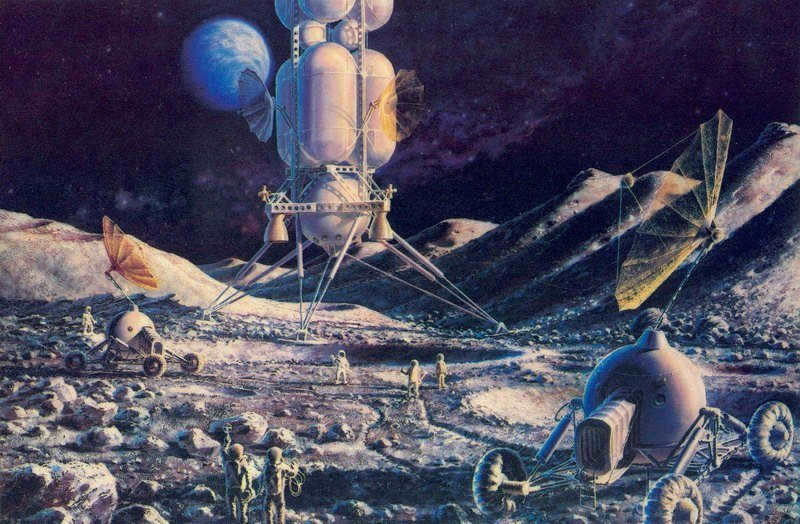
Different Types of Astronomy and Its Main Sections
Astronomy, as a scientific discipline, can be categorized into various sections. These sections are interconnected, and their division is somewhat arbitrary.
The primary sections of astronomy include:
- Astrometry – This field focuses on the study of the position and movement of celestial bodies.
- Position or spherical astronomy – This branch investigates the methods used to determine the position of cosmic objects from different observational points. It is often considered a part of astrometry.
- Celestial mechanics – This area of study examines the laws governing the motion of celestial bodies under the influence of universal gravitation. It is one of the oldest branches of astronomy.
- Astrophysics is the field of study that focuses on understanding the physical and chemical characteristics of celestial objects. It is composed of two main sub-disciplines, cosmochemistry and stellar astronomy. Cosmochemistry investigates the chemical composition of objects in space, helping to reveal patterns in the distribution of elements throughout the universe. Stellar astronomy, on the other hand, examines the movement and distribution of stars and stellar systems, while also considering the underlying physical laws.
- Cosmology is a branch of astrophysics that explores the general laws, properties, and evolution of the entire universe.
- Cosmogony is a field of study that delves into the origins, development, and evolution of cosmic bodies.
Stages in the Evolution of Astronomy
The development of astronomy can be divided into several distinct stages, each with its own unique characteristics and contributions.
Pre-scientific Era
The earliest observations of celestial bodies can be traced back to ancient times. During this period, astronomy was primarily descriptive in nature and often intertwined with the practice of astrology.
Astrology is a belief system and set of practices that posits the influence of cosmic phenomena on human life. Astrologers believed that by studying the stars, they could predict future events.
Ancient Egypt played a significant role in the advancement of astronomy. The Egyptians, through their observations of Sirius, were able to predict the annual flooding of the Nile River, a crucial development for the advancement of agriculture.
The priests from the ancient city of Babylon were responsible for identifying numerous constellations and the zodiacal circle, as well as creating various astronomical tables. Additionally, the Babylonians were able to discover certain laws of planetary motion, including those of the Sun and the Moon, and even developed a fairly accurate lunar calendar.
Significant advancements in the field of astronomy occurred during the time of Ancient Greece. Many of the names used in modern science are derived from ancient Greek terms. Aristotle, for instance, proposed that the Earth was a spherical shape and even attempted to calculate its size.
The names of the planets, as we know them today, originated from ancient Roman gods, whose names were directly borrowed from Greek mythology. For example, Venus is named after the goddess of love, while Mars is named after the god of war.
Known as the geocentric system, the belief that the Earth was the center of the universe was formulated by the Hellenic astronomer Claudius Ptolemy and remained in place from the 2nd century AD until the Renaissance period.
Modern times
The foundations of astronomy as a science were established during the Modern Age (16th-19th centuries).
During this period, three significant events occurred:
- The introduction of the heliocentric model of the solar system. The 16th-century Polish astronomer Nicolaus Copernicus was the first scientist to scientifically propose and attempt to prove that the Earth is not the center of the universe and instead revolves around the Sun. Despite facing persecution from the church, the heliocentric model gradually gained acceptance in scientific communities.
- The telescope: a groundbreaking invention. An extraordinary advancement in the field of astronomy came with the creation of the telescope, which allowed scientists to observe and analyze celestial objects. One of the pioneers in this field was the Italian astronomer Galileo Galilei, who constructed one of the earliest telescopes. Through his observations, Galileo made several significant astronomical breakthroughs, including the revelation of lunar mountains.
- The law of universal gravitation: a momentous discovery. In the late 17th century, Isaac Newton, an English physicist, mathematician, and astronomer, unveiled a law that explained the interaction of gravitational forces.
The Modern Age witnessed a wealth of knowledge being amassed about the solar system and the physical characteristics of planets and other celestial bodies.
Modern era
Astronomy has undergone a significant transformation in the 20th-21st century, thanks to scientific and technological advancements. The introduction of powerful optical and radio telescopes, as well as the launch of space satellites and orbital stations, have revolutionized the field.
The first human space flight, conducted on April 12, 1961 by Soviet cosmonaut Yuri Gagarin, served as a major catalyst for the advancement of astronomy.
Additionally, the discovery of other galaxies in the 20th century has greatly accelerated the progress of extragalactic astronomy.
Perhaps the most significant milestone in this era was Albert Einstein’s revelation of the theory of relativity, which has had profound implications for the future of astronomy.
How astronomy is connected to other sciences, with examples
Astronomy maintains strong connections with multiple scientific disciplines. It not only influences these fields, but also draws inspiration and methods from them.
Relationship with physics
Astronomy shares the closest bond with physics. There is no fundamental distinction between terrestrial and celestial phenomena. Both are explained using the same theories, and they follow the same laws.
All matter in the universe adheres to the law of universal gravitation, which can be utilized to describe the interactions between stars.
Optics, a crucial branch of physics, plays a significant role in the advancement of astronomy. Through the use of powerful optical telescopes, scientists are able to examine celestial objects in great detail.
The strong connection between these fields of study has led to the emergence of a unique scientific discipline known as astrophysics. Astrophysics focuses on the examination of the physical properties of celestial bodies.
The Relationship with Chemistry
Astronomers also explore the chemical composition of stars and other celestial entities, investigating the distribution of chemical elements throughout the universe. In this endeavor, they utilize the knowledge, laws, and methodologies of the chemical sciences. At the intersection of these two disciplines lies the field of astrochemistry.
Astrochemistry is a scientific field dedicated to the study of chemical reactions within the interstellar medium.
One of the primary objectives of astrochemistry is to provide explanations for the origin of chemical compounds discovered within the universe.
By combining the fields of astronomy and chemistry, scientists have made exciting discoveries involving new chemical elements found in the atmospheres of stars.
Connection to mathematics
Mathematics has played a crucial role in the development of astronomy since its inception. Mathematical methods have been essential in calculating the coordinates of celestial bodies and determining their distance from Earth. Even ancient astronomers relied on geometric constructions and mathematical calculations to create star tables.
The launch of satellites and orbital stations also relies heavily on mathematical formulas.
The mathematical framework serves as the foundation of classical astronomy.
Thanks to astronomical observations, ancient civilizations gained the ability to ascertain their position. The stars served as a guide for naval vessels, ensuring they didn’t lose their course.
Astronomy grants us the opportunity to explore the Earth not just from its surface, but from the vantage point of space as well.
Pictures captured from space offer us a glimpse into the contours of the landmasses and oceans, the weather patterns, and the condition of the environment.
Connection to computer science
Information technology plays a crucial role in modern astronomy. Computers enable astronomers to perform complex calculations quickly and efficiently.
Electronic devices and instruments powered by computer technology are utilized in the launching of rockets and satellites.
Furthermore, computer science has also contributed to the development of specialized programs that simulate various space processes.
Connection to biology and ecology
The impact of various astronomical phenomena on biology and ecology is a subject of study. Researchers conduct experiments on orbital stations to investigate the effects of weightlessness on living organisms.
Biological methods are employed to prepare astronauts for the harsh stresses that their bodies will face in space.
In the mid-20th century, a new interdisciplinary field emerged – astrobiology. It focuses on studying the origins, evolution, and potential existence of life on other planets.
From space, it is possible to monitor environmental issues on Earth, such as deforestation.
Connections between astronomy, philosophy, social sciences, and humanities
Astronomy is closely related to philosophy and the humanities because it addresses various fundamental questions, such as:
- The structure of the universe
- The origin of life
- Evolutionary processes
- The place of humans in the universe
- The impact of cosmic processes on human life
These questions are also discussed and explored in the fields of philosophy, history, and literature.
Ancient philosophy, in particular, had diverse perspectives on the structure of the universe.
Another emerging scientific discipline is called archaeoastronomy. Researchers in this field study the knowledge about the cosmos held by people in ancient civilizations. This provides valuable insights for anthropology and history, and helps in dating ancient structures.

Currently, there are additional cumulative discounts (ranging from 2% to 25%) available to a total of 58,742 educational institutions. To determine the specific discount applicable to all staff members within your educational institution, please sign in to your personal Infoworks account.


Are you interested in a professional retraining course?
Discover the benefits of becoming a hockey coach
If you and your colleagues are interested in taking Infowrok courses, we can offer a special discount. The amount of the discount depends on how many of your colleagues have already enrolled in our courses.
Currently, we provide additional discounts (ranging from 2% to 25%) to 58,742 educational institutions. To find out the exact discount that applies to your educational institution, please log in to your personal Infoworks account.




Advanced training program
Specifics of preparing for the Comprehensive Test within the framework of monitoring the educational quality of students in the “History” subject in the context of implementing the FSES SOO.
We can include the discount provided by your educational institution in addition to this discount (the amount depends on how many of your colleagues have completed Infoworks courses)
Currently, 58,742 educational institutions are eligible for additional discounts (ranging from 2% to 25%). To find out the applicable discount for all staff members of your educational institution, please log in to your personal Infoworks account.


Exploring the Importance of Astronomy
Providing an Overview of the Presentation:

Slide 1: Astronomy and its correlation with other scientific disciplines. The significance of astronomy in the advancement of society.
Distinctive characteristics of astronomical investigation techniques. Telescopes and the underlying principle of their operation.
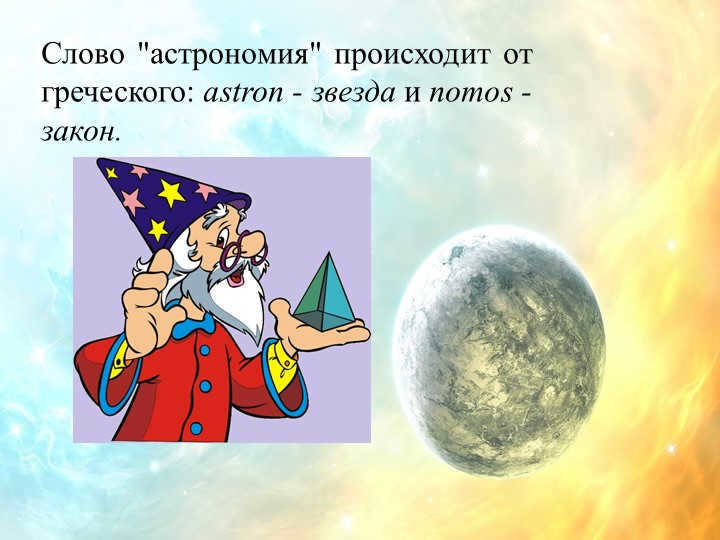
Slide number 3 focuses on ASTRONOMY, which is a scientific discipline that explores the movement, composition, genesis, and evolution of celestial entities and their interconnected systems.

Astronomy, which has its roots in the Stone Age (VI-III millennia BC), is considered one of the oldest sciences in existence.

Slide 6. An observatory is a unique building designed to enable the study and examination of a range of astronomical and occasionally earthly events through the use of a sizable telescope.
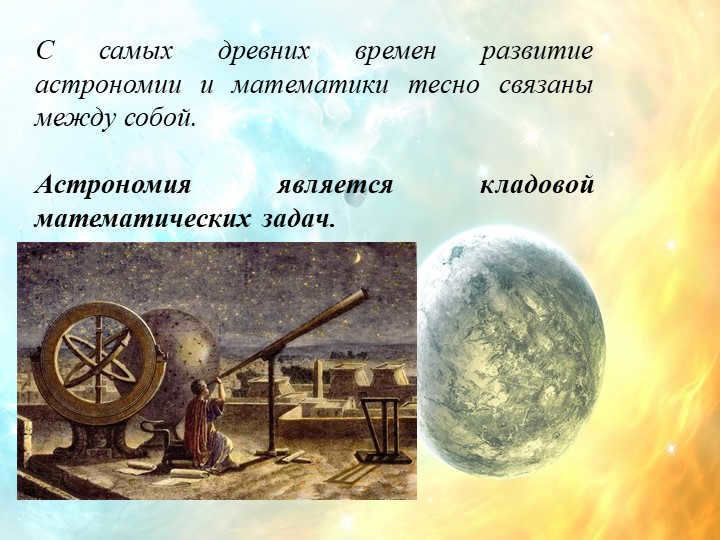
7 slide Throughout history, astronomy and mathematics have been intricately intertwined.
Astronomy has always provided a wealth of mathematical challenges.
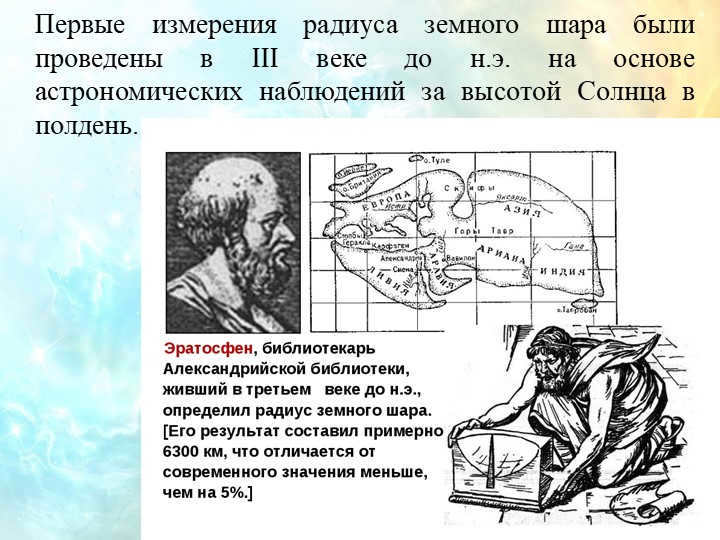
In the 3rd century BC, the radius of the Earth was first determined through astronomical observations of the Sun’s height at noon.
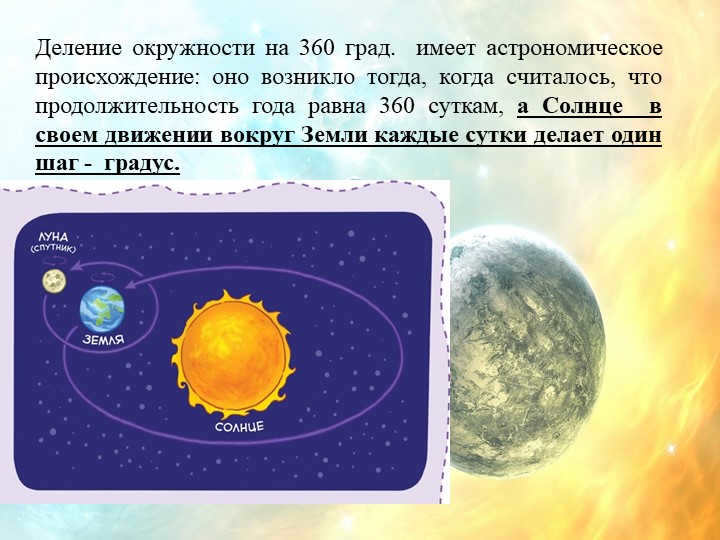
Slide number 9. The concept of dividing a circle into 360 degrees has its roots in astronomy. This division was first introduced when it was believed that a year consists of 360 days, and that the Sun moves one degree around the Earth each day.
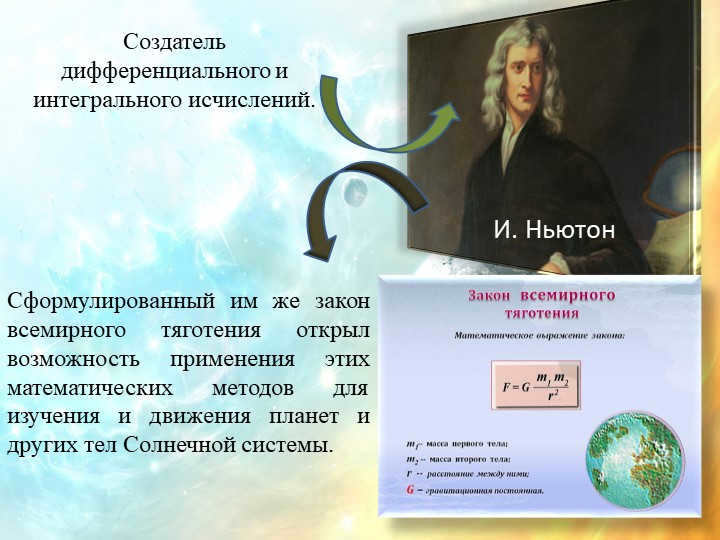

10 slide The individual who devised differential and integral calculus.
He presented the law of universal gravitation, which provided the opportunity to employ these mathematical techniques in observing and tracking the movements of the planets and other celestial bodies within the solar system.
I. Newton
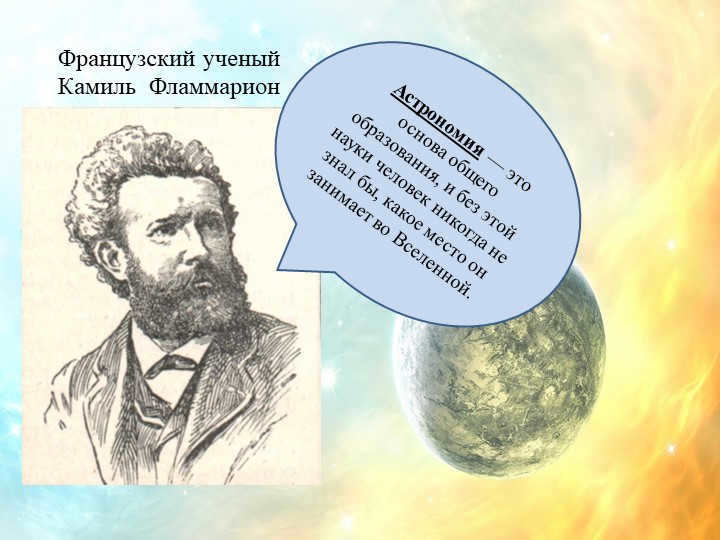
Slide 11 French scientist Camille Flammarion
Astronomy serves as the fundamental pillar of general education, and without this field of study, humankind would remain oblivious to its position within the vast expanse of the universe.
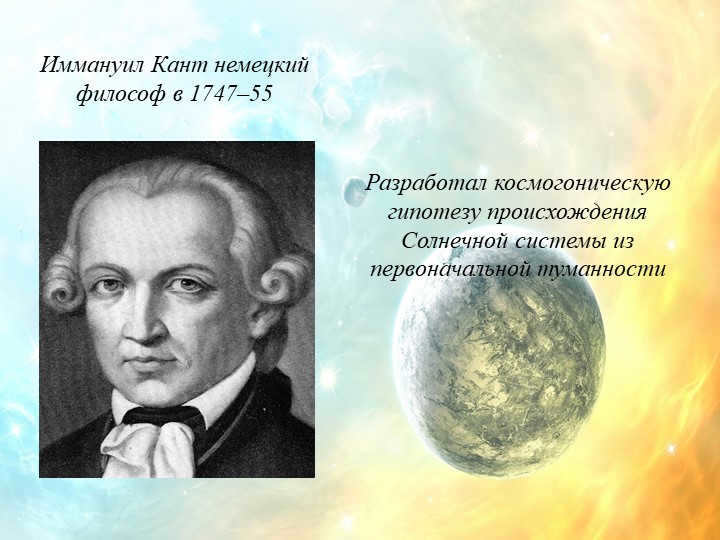
In 1747-55, Immanuel Kant, a German philosopher, presented a theory about the formation of the solar system. According to his cosmogonic hypothesis, the solar system originated from the original nebulae.
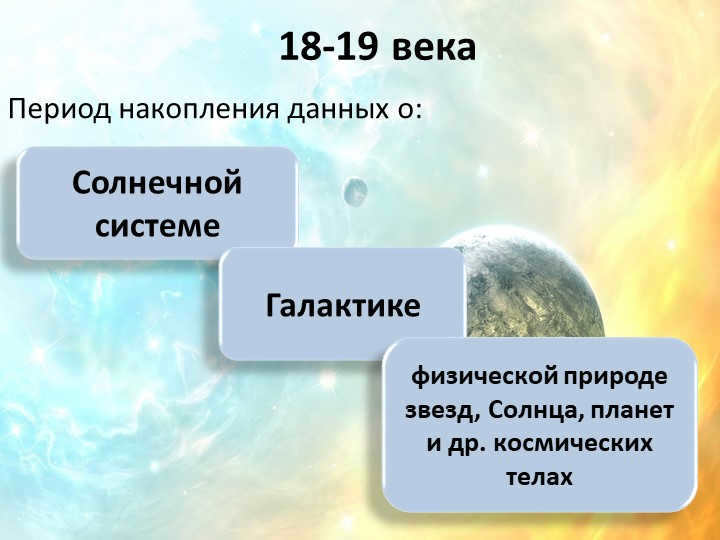
During the 18th and 19th centuries, there was a period of gathering information concerning:
The Solar system
The Galaxy
The physical characteristics of stars, the Sun, planets, and other celestial bodies
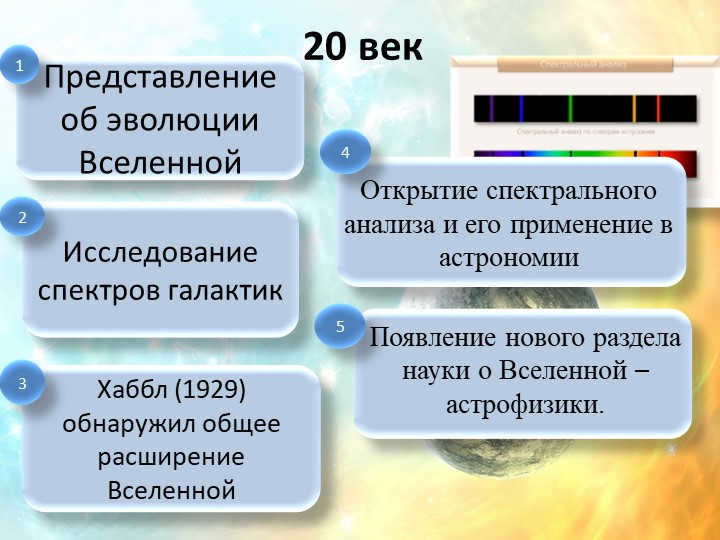
Slide 14 of the 20th century
An introduction to the progression of the cosmos
Exploration of galaxy spectra
In 1929, Hubble made the groundbreaking discovery of the universe’s general expansion
Unveiling the significance of spectral analysis and its application in the field of astronomy
The emergence of astrophysics as a new branch of scientific study
1
2
3
4
5
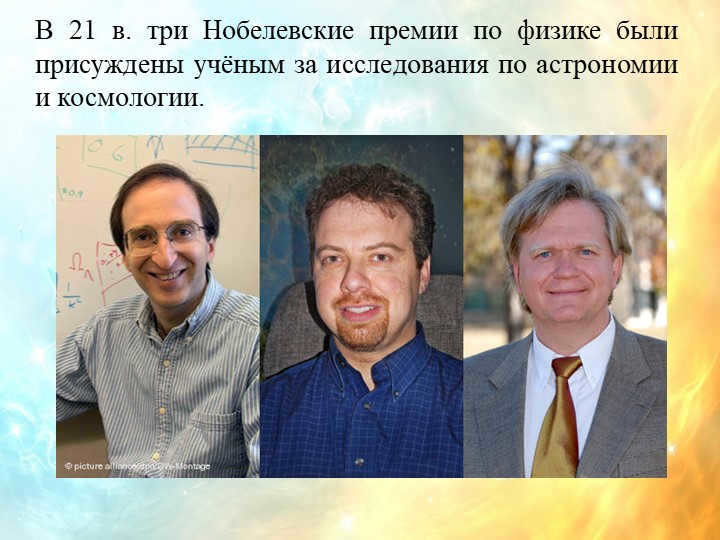
During the 21st century, researchers in the field of astronomy and cosmology were honored with three Nobel Prizes in Physics.

Slide 16: Spherical astronomy.
The field of astronomy is comprised of the subsequent divisions:
Stellar observation
Celestial motion
Astrophysical science
Applied astronomy
Study of galaxies beyond the Milky Way
Origin of the universe
Study of the universe as a whole
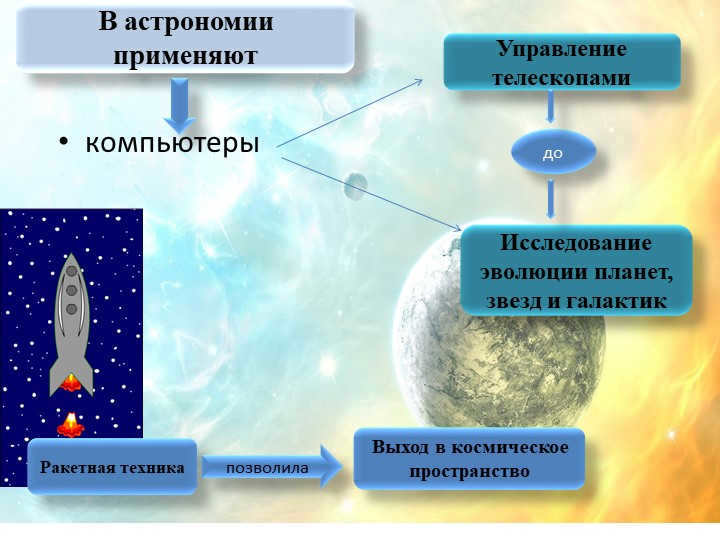
Computers have revolutionized the management of telescopes in the field of astronomy. They are used to control telescopes, allowing astronomers to easily navigate and focus on celestial objects. In addition to telescope control, computers have various applications in astronomy. One such application is the investigation of the evolution of planets, stars, and galaxies. By utilizing computer technology, astronomers are able to study the changes and developments that occur in these celestial bodies over time. Furthermore, computers have played a crucial role in rocket technology, which has enabled humans to access outer space. Thanks to the advancements in computer technology, astronauts are able to safely travel beyond the Earth’s atmosphere and explore the mysteries of the universe.

There is a collection of celestial bodies in the solar system, including Earth, its moon, other planets, their satellites, comets, and small planets. All these objects revolve around the Sun.
Our Galaxy, which includes the Sun and all the other stars visible in the sky, is a vast star system.
Moreover, there are numerous other galaxies similar to ours in the Universe.
1
2
3
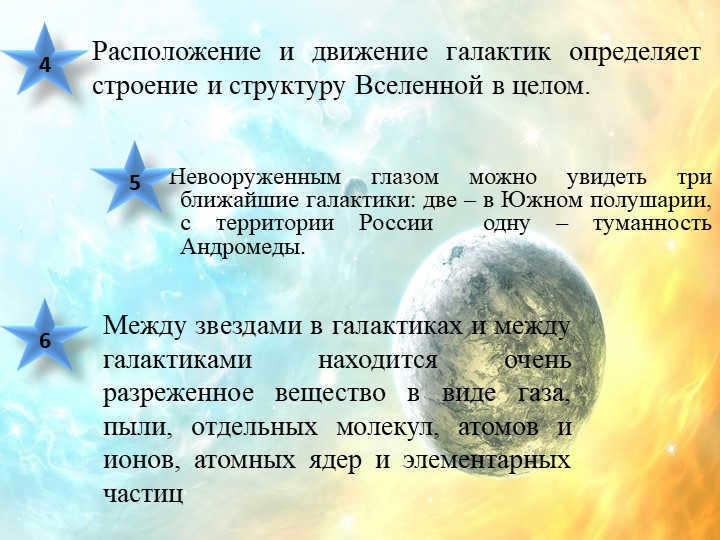
Slide number 20. The structure and arrangement of galaxies are crucial in defining the overall structure and composition of the Universe.
The naked eye can observe three nearby galaxies: two in the Southern Hemisphere and one from Russia, known as the Andromeda Nebula.
In the space between stars within galaxies and between galaxies, there exists a sparsely populated matter consisting of gas, dust, individual molecules, atoms, ions, atomic nuclei, and elementary particles.
4
5
6

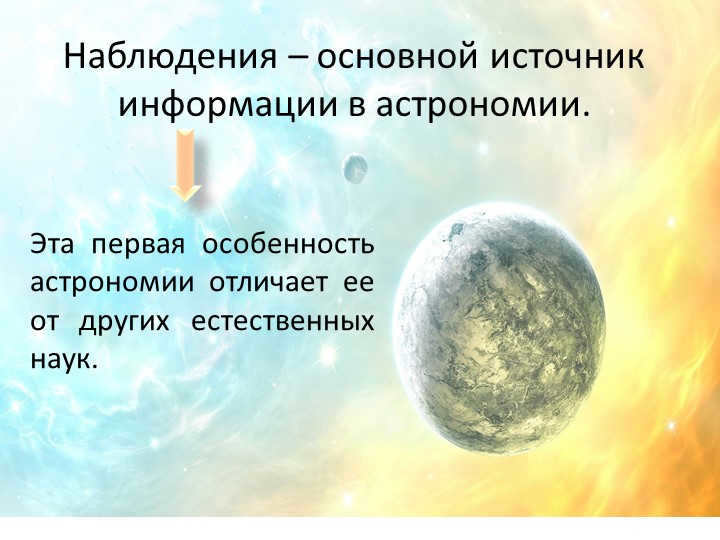
Observations play a crucial role in the field of astronomy, serving as the main source of information. This fundamental characteristic sets astronomy apart from other branches of natural science.
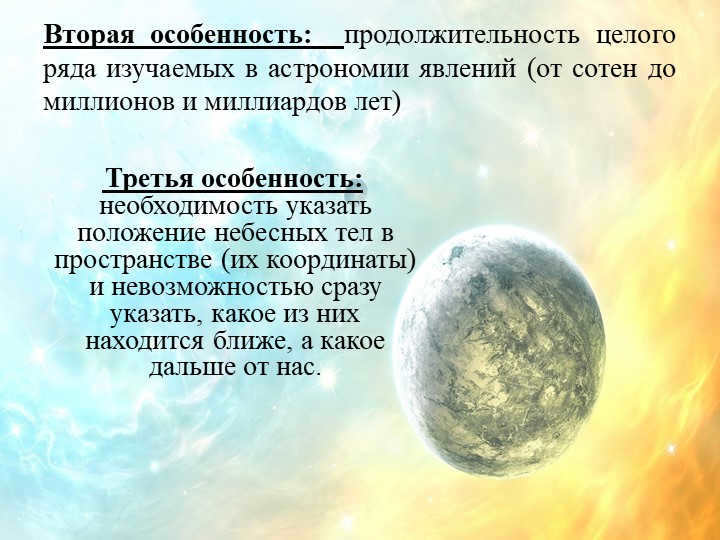

Slide 23: The second feature of astronomy is the study of phenomena that occur over a wide range of time, ranging from hundreds to millions and billions of years.
The third characteristic is the need to determine the position of celestial bodies in space, known as their coordinates. This is a challenging task as it is not possible to determine immediately which celestial body is closer or farther from us.
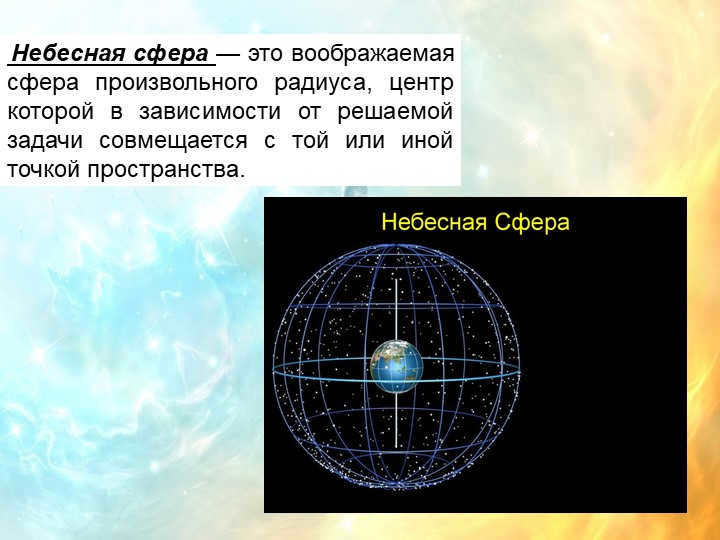
24 slide The celestial sphere is a hypothetical sphere with a radius that can be any value. Its center is located at a specific point in space, depending on the specific problem that needs to be addressed.
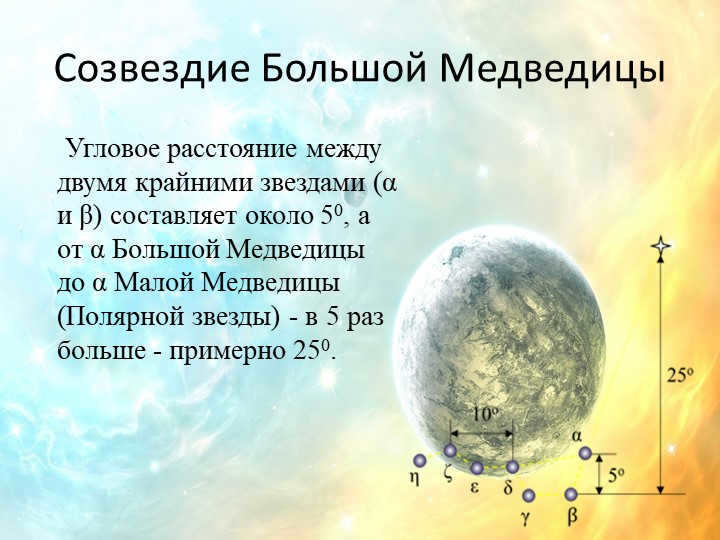

Slide 25 The Big Dipper constellation
The angular separation between the two outermost stars (α and β) is approximately 50, and from α of the Big Dipper to α of the Little Dipper (Polaris) is five times greater – around 250.

Slide number 26. Another way to estimate angular distances is by using the fingers of a hand that is stretched out.
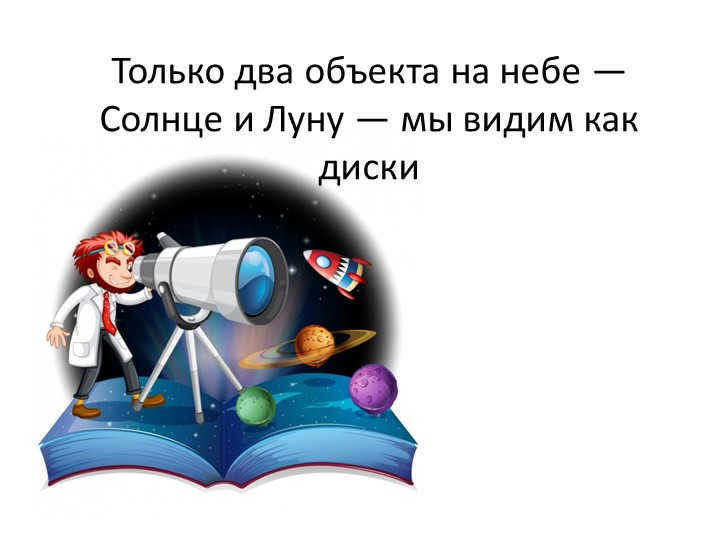
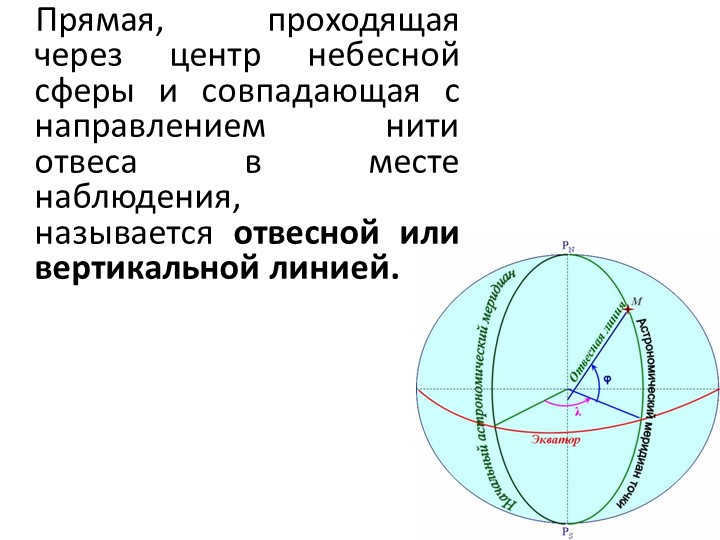
A plumb or vertical line is known as a straight line that passes through the center of the celestial sphere and aligns with the direction of the plumb line at the observation location.
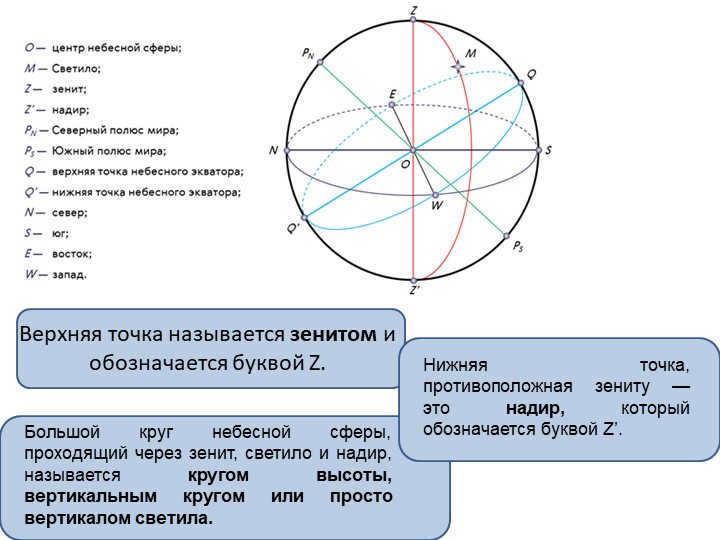

Slide 30: The highest point is known as the zenith and is represented by the letter Z.
The point opposite the zenith is called the nadir, which is represented by the letter Z’.
The circle that passes through the zenith, the luminary, and the nadir on the celestial sphere is known as the altitude circle, the vertical circle, or simply the luminary’s vertical.
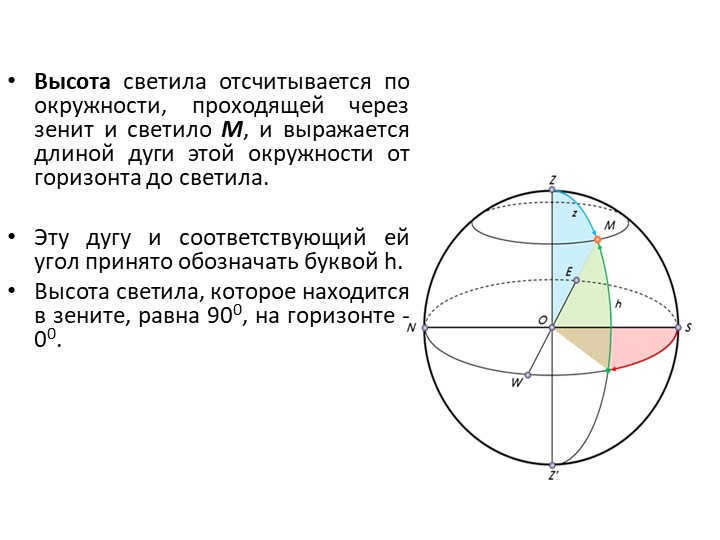
31 Slide The altitude of a celestial body is determined by measuring the length of the arc on a circle passing through the zenith and the celestial body M, and is represented by h. This arc and its corresponding angle are denoted by the letter h. The altitude of a celestial body at the zenith is 900, while at the horizon it is 00.
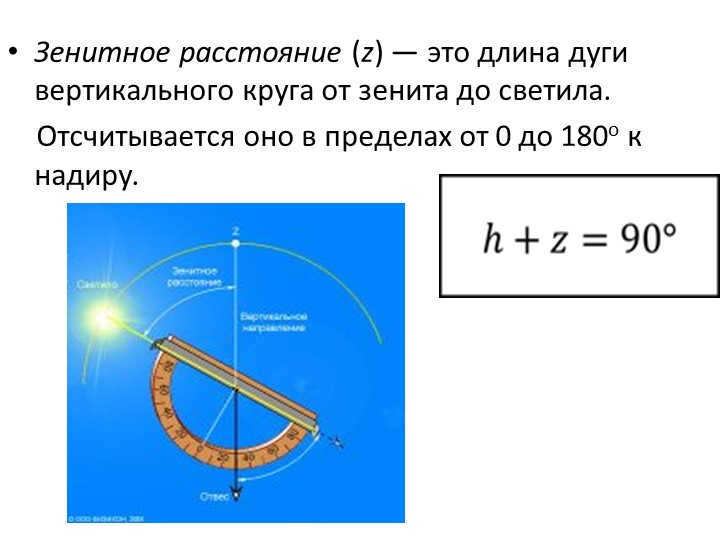
Slide 32 The zenith distance (z) represents the extent of the arc of a vertical circle between the zenith and the celestial object.
Its measurement ranges from 0 to 180 degrees towards the nadir.
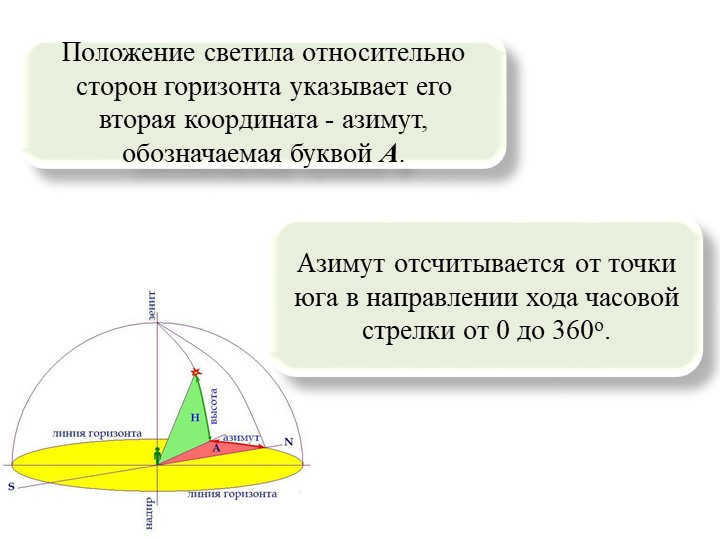

33 Slide The second coordinate of the luminary indicates its position relative to the sides of the horizon, which is known as azimuth and represented by the letter A.
Azimuth is measured in degrees from a point south in the clockwise direction, ranging from 0 to 360o.
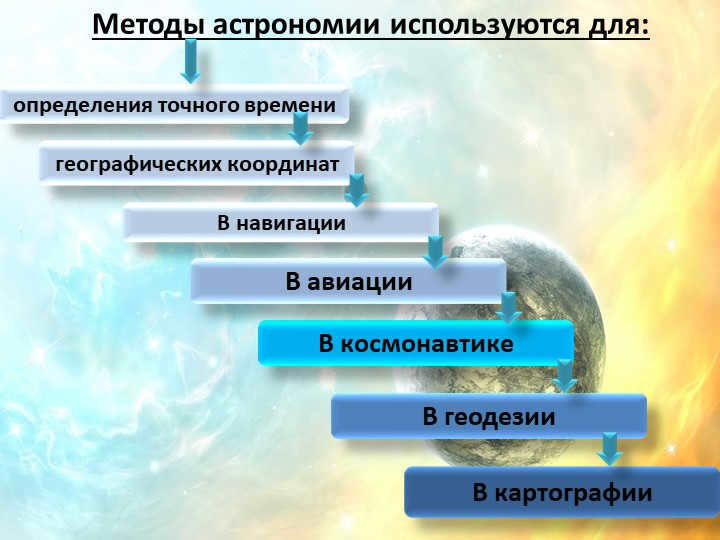

Slide 34: Astronomy is utilized for several purposes including:
– Determining precise time
– Calculating geographic coordinates
– Assisting in navigation
– Supporting astronautics
– Aiding in aviation
– Contributing to cartography
– Assisting in geodesy
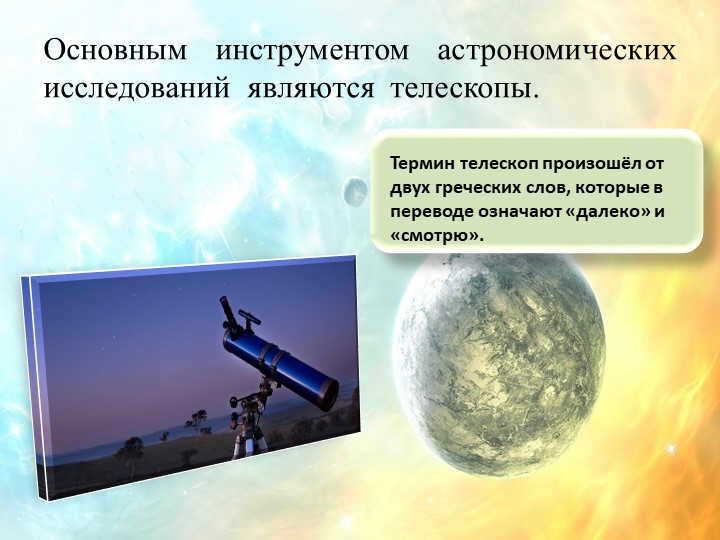
Slide 35: The primary tool used for studying celestial objects is telescopes.
The word “telescope” originates from two Greek words that, when translated, mean “far” and “looking”.
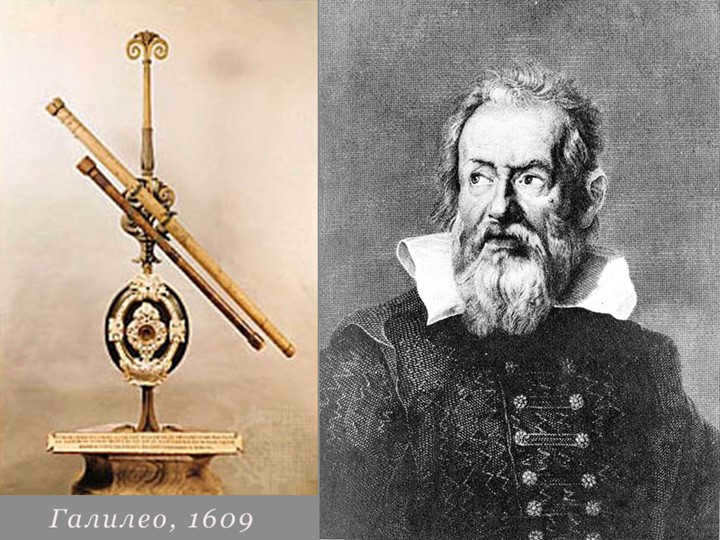
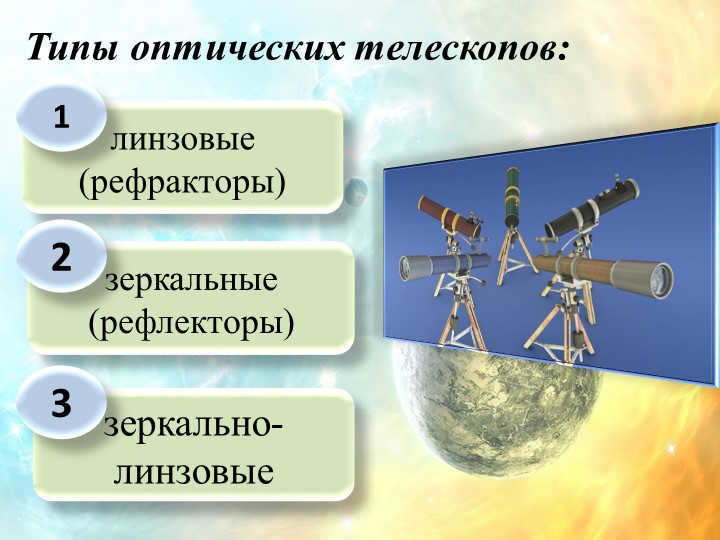
There are 37 different types of optical telescopes, including lenticular (refractors), mirror (reflectors), and mirror-lens telescopes. Some examples of these types include 1, 2, and 3.


Slide 38: The operation of an optical telescope is determined by its type, but they all have a common objective:
– to gather as much light as possible from celestial bodies,
– to generate images of these celestial bodies,
– and to concentrate the light rays onto the energy-receiving device.
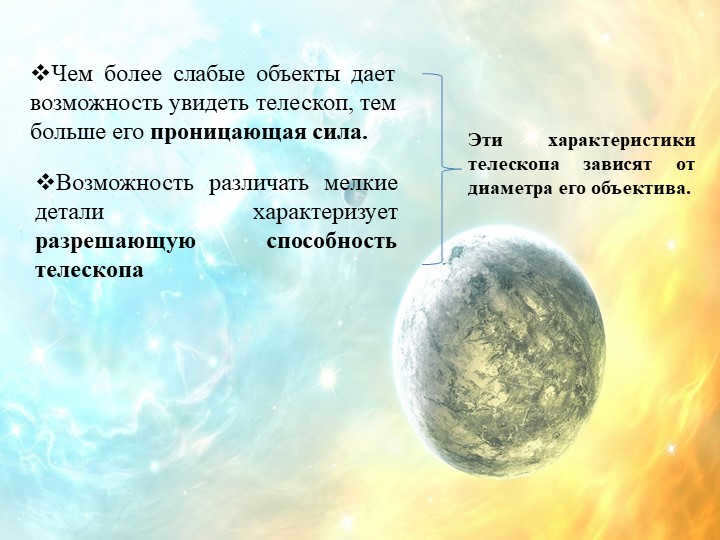

39 Slide The more faint objects a telescope is capable of seeing, the stronger its ability to penetrate.
The telescope’s resolving power is determined by its ability to distinguish small details.
These features of a telescope are influenced by the size of its lens.


Slide 40: When the separation between the images of two stars is smaller than the size of the image itself, they combine to form a single image.
Due to the phenomenon of diffraction, the image of a star appears not as a point, but as a bright spot known as a diffraction disk. The angular diameter of this disk is determined by the formula:
λ – the wavelength of light, D – the diameter of the telescope lens, 206265 – the number of seconds in a radian.
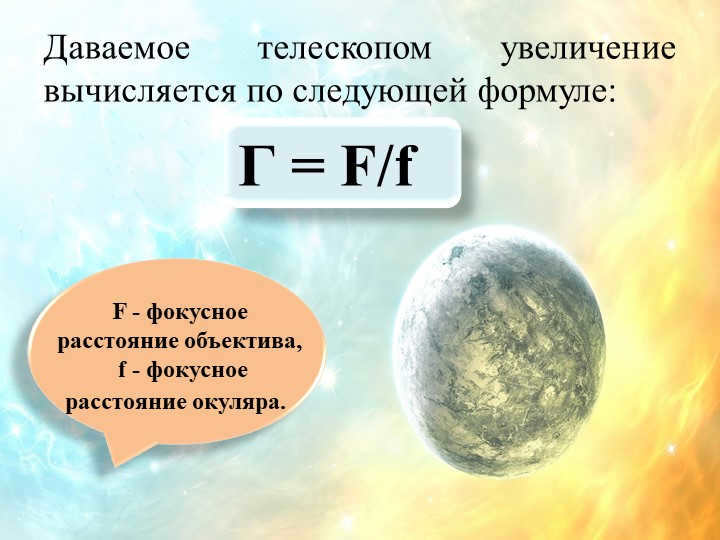
Slide 41: The telescope’s magnification can be determined using the following equation:
F is the focal length of the objective lens,
f is the focal length of the eyepiece.
G can be calculated using the formula G = F/f.
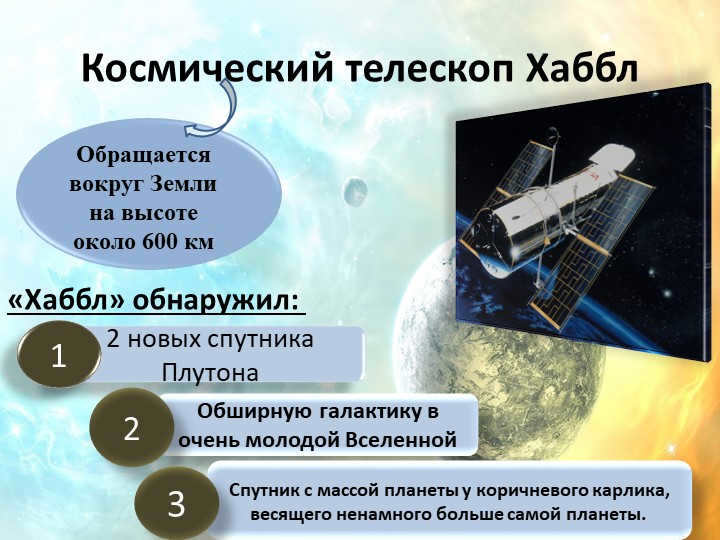
The Hubble Space Telescope, which revolves around the Earth at an altitude of approximately 600 kilometers, has made several significant discoveries. These include the identification of two new satellites of Pluto, the observation of a vast galaxy in a very young universe, and the detection of a satellite with the mass of a planet orbiting a brown dwarf that weighs just slightly more than the planet itself. These findings have contributed to our understanding of the universe.
